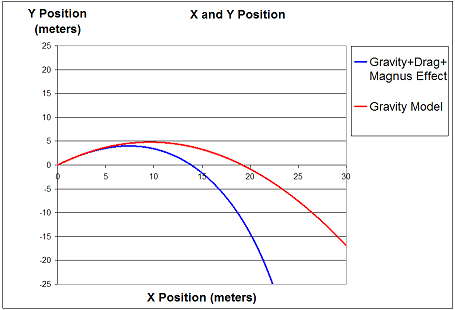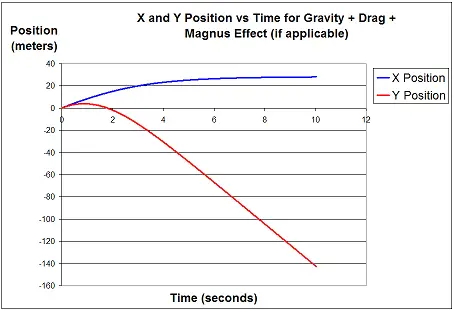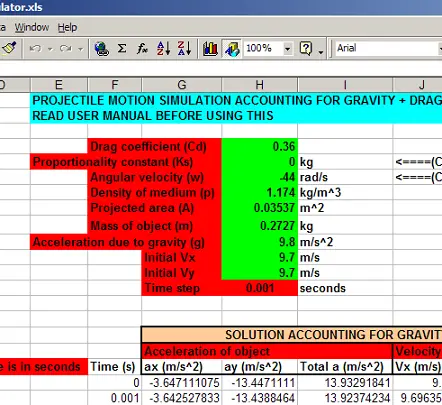Projectile Motion Simulator
I created a projectile motion simulator which accounts for the effect of air resistance (drag) and the Magnus effect. This simulator is programmed in Microsoft Excel and simulates the motion of a projectile traveling through the air, while being acted upon by the force of gravity, drag, and (optionally) the Magnus effect. This projectile motion simulation program is very useful for estimating the actual flight path of a projectile (e.g. a baseball), with often much greater accuracy than is predicted by equations of motion which account only for the effect of gravity.
A user manual in PDF format is included with the Excel program. The manual shows you how to use the Excel program, and also shows the derivation of the equations of motion for a projectile which is acted upon by the force of gravity, drag, and (optionally) the Magnus effect. The Excel program optionally allows you to include the influence of the Magnus effect for spherical spinning objects which rotate in the vertical plane (i.e. the plane of motion of the projectile).
The simulator is straightforward to use and since it is programmed in Excel the data is displayed automatically in charts, for easy reference.
The two figures below show examples of the charts generated by the Excel spreadsheet. In the first chart you can compare the motion of a projectile under the influence of gravity, drag, and (optionally) the Magnus effect, to the theoretical motion of the projectile with only gravity present. This gives you an easy way of seeing the difference between the two.


Below is a screen capture of the Excel spreadsheet.

With the simulator you can also:
• Determine the terminal speed of a projectile under the influence of gravity and drag, and determine approximately how long it takes to reach terminal speed. For example, you can estimate how long it takes a skydiver to reach terminal speed after jumping from the plane.
• Determine the instantaneous acceleration of a projectile under the influence of gravity, drag, and (optionally) the Magnus effect.
Assumptions made when using the simulator:
• The motion of the projectile occurs in the vertical plane. Thus, its motion is two-dimensional.
• There is negligible wind.
All the files that come with this projectile motion simulator are contained in a single (compressed) file, in the "zip" format. This file is 2.5 MB in size. You need to uncompress this file before you can access it.
To use the projectile motion simulator program you need to have Microsoft Excel installed on your computer. The program is compatible with all versions of Excel. The simulator is available for download here.
Return to Kinematics page
Return to Real World Physics Problems home page
Free Newsletter
Subscribe to my free newsletter below. In it I explore physics ideas that seem like science fiction but could become reality in the distant future. I develop these ideas with the help of AI. I will send it out a few times a month.